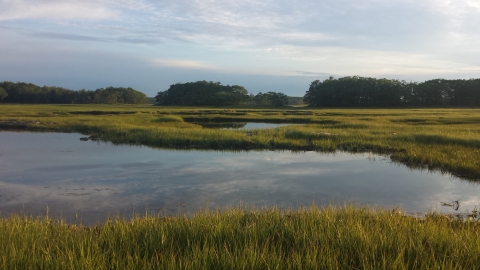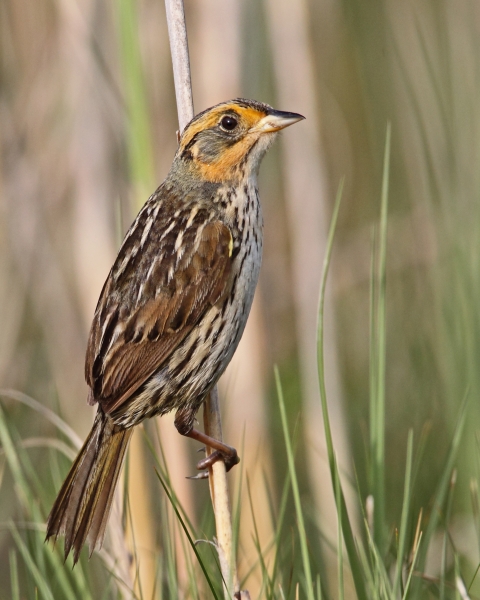You don’t need to tell Karl Stromayer climate change climate change
Climate change includes both global warming driven by human-induced emissions of greenhouse gases and the resulting large-scale shifts in weather patterns. Though there have been previous periods of climatic change, since the mid-20th century humans have had an unprecedented impact on Earth's climate system and caused change on a global scale.
Learn more about climate change is the existential threat of our time; he lives that reality every day. As manager of Maine’s Rachel Carson National Wildlife Refuge, he’s watching as the sea creeps up on the refuge’s salt marshes. And he's taking action.
Stromayer’s racing the clock to bolster the refuge — created to protect precious coastal habitat — by helping existing marsh move inland as sea-level rise encroaches. But he can’t do it alone.
Fortunately, he has a team of dedicated conservation groups with complementary strengths at his side. Working together with patience and persistence, these collaborators are protecting the salt marshes of the future.
Salt marshes are found in tidal areas near the coast, where freshwater mixes with saltwater.
Learn more about salt marsh habitat may be gone due to sea-level rise.
Marsh on the move
Set up in 1966 to conserve salt marsh for migratory birds, the refuge now includes more than 5,800 acres along 50 miles of southern Maine’s coast. In the early years, development was the primary threat to the refuge’s mission, but now sea-level rise caused by climate change is jeopardizing refuge and non-refuge lands alike. By 2100, half the refuge’s salt marsh will likely be underwater due to a predicted six-foot rise in sea levels.
“When the refuge was established, climate change wasn’t the known challenge it is now,” Stromayer said. “Our current lands aren’t ideally situated for all the species we hope to protect in the long term.”
Conserving existing salt marsh is no longer enough; to keep pace with rising seas, Stromayer looks for sites where salt marsh can migrate inland. That means finding marshes backed by open meadows, pastures and even forested uplands that can morph into marsh when higher daily tides reach them in the future.
“Preparing for climate change is one of our key priorities and the importance of salt marsh migration can't be overemphasized,” Stromayer said.
Opportunity knocks
In early winter 2022, Doreen MacGillis, land protection specialist at York Land Trust, learned a prime piece of coastal property on the upper York River would soon be sold — a house with 52 acres of salt marsh, hayfield and pasture.
Well aware of its ecological value and potential for marsh migration, she reached out to Keith Fletcher, southern Maine project manager at Maine Coast Heritage Trust. The two met with the seller, who supported conserving the land.
The parcel lay within not only the refuge’s acquisition boundary but also regional, state and local priority conservation areas. And, in 2023, the York River became the newest nationally recognized partnership wild and scenic river, protected by its community.
“This property was on everybody’s priority list for years,” Fletcher said.
Conservation powers, activate!
While the U.S. Fish and Wildlife Service, York Land Trust and Maine Coast Heritage Trust all wanted the parcel protected, none of them could do it independently. It would take teamwork … and trust.
All three agreed that, due to the property’s abundant wildlife and plant species, it belonged in Rachel Carson Refuge. And while Stromayer was confident he could line up government funding for the purchase, it would take time — something in short supply in the real estate world.
This is where land trusts shine. With cash on hand and the generosity of a private donor, Maine Coast Heritage Trust and York Land Trust split the cost of the purchase. They sold the house, along with five acres, and held the remaining 47 acres until the title to the land could be transferred to the refuge.
“We agreed to share the risks and rewards of the project,” Fletcher said. “We’ve partnered on a dozen projects in different ways, and we had faith we'd get some money back on the sale of the house.”
Before this land was even available, Stromayer had applied for money from the federal Land and Water Conservation Fund — created by Congress in 1964 to safeguard public lands and waters using revenues from offshore oil and gas drilling — to purchase future salt marsh habitat for the refuge. In 2020, as part of the Great American Outdoors Act Great American Outdoors Act
This landmark conservation law, enacted in 2020, authorizes the use of up to $1.9 billion a year in energy development revenues for five years for needed maintenance to facilities and infrastructure in our wildlife refuges, national parks, forests, recreation areas and American Indian schools.
Learn more about Great American Outdoors Act , Congress permanently authorized the fund and set the annual appropriation at $900 million.
In 2023, Rachel Carson Refuge received $2 million from the fund, more than enough to buy the 47-acre parcel from Maine Coast Heritage Trust. In January 2024, two years after the property came on the market, it became part of the refuge.
“This project required all three organizations to meet its funding, resource and timeline needs,” said Amelia Nadilo, executive director of York Land Trust. “It highlights what can be achieved through collaboration.”
One other partner was key to protecting the land: Friends of Rachel Carson National Wildlife Refuge has long advocated for adding acres to the refuge. The group helped secure the Land and Water Conservation Fund money for the acquisition.
A RAD-ical idea
Supporting habitat transformation is a paradigm shift for refuge managers like Stromayer, who’ve long sought to undo the effects of human activities and invasive species invasive species
An invasive species is any plant or animal that has spread or been introduced into a new area where they are, or could, cause harm to the environment, economy, or human, animal, or plant health. Their unwelcome presence can destroy ecosystems and cost millions of dollars.
Learn more about invasive species to return lands to historical conditions. In a changing climate, historical conditions may no longer be desirable, or possible.
Instead, the Service and other federal natural resource agencies have adopted the Resist-Accept-Direct, or RAD, framework. Building upon decades of research for managing wildlife in the face of rapid change, it offers three pathways for managers to consider when approaching conservation:
- Resist by counteracting changes and restoring habitats and populations to baseline conditions (the traditional wildlife management approach)
- Accept by allowing habitats to transition without intervention
- Direct by working alongside occurring transformations, steering change to support a variety of fish and wildlife and safeguard nature’s benefits to people
Stromayer and refuge wildlife biologist Kate O’Brien envision directing inland migration of the existing salt marsh habitat at the parcel by maintaining the open grassland behind it with habitat management tools such as mowing and prescribed fire. This spring, O’Brien will lead a team to assess the new parcel, surveying birds, plants, soil, and more, to get a better a sense of the health of system.
Depending on what they find, staff may also resist immediate changes by restoring the natural function of the current marsh.
“The York River is unique in that it’s more of an inland salt marsh,” O’Brien said. “We’re hoping that feature gives it a buffer over sea-level rise, but this is a spot where, decades from now, I fully expect salt marsh migration to occur.”
Hope is the thing with feathers
O'Brien hopes to find at least one saltmarsh sparrow at the marsh. This gray-buff-and-brown songbird with a face striped in saffron nests only in Northeast salt marshes. Its numbers are declining at an alarming rate as rising seas flood nests, setting eggs afloat and drowning hatchlings. Without our help, the species could go extinct in the next decade.
“We can tell from older surveys, other marshes we’ve conserved, and features of the upper York River parcel that saltmarsh sparrows are likely nesting there,” O’Brien said. “It would be very unlikely to have them not be there.”
In addition to saltmarsh sparrows, the parcel may support other species considered by the Service and its partners to be at risk of steep population declines, including fishes like alewife and shorebirds like American oystercatcher.
For the greater good
The benefits of conserving the upper York River parcel extend beyond the needs of wildlife to those of people. Sea-level rise and increasingly frequent severe storms threaten public safety on Maine’s coast. Healthy salt marshes act as sponges, absorbing higher tides, storm surge and run-off from heavy rains.
“We’re experiencing more frequent flooding in York,” Nadilo said. “People are seeing it in real time; the narrative is shifting to ‘We’re living in a climate-changed world.’”
Conserving the current and future salt marsh at the parcel strengthens the coast in the face of climate change while sustaining the area’s scenic, recreational and historical resources.
Healthy marshes also store carbon, a climate pollutant, in their soils, keeping it out of the atmosphere. When they’re degraded or lost, that stored carbon is released.
Think globally, act locally
Recognizing the enormous value of salt marshes, the U.S. Department of the Interior launched the Salt Marsh Keystone Initiative in January 2024. With funding support from the Bipartisan Infrastructure Law Bipartisan Infrastructure Law
The Bipartisan Infrastructure Law (BIL) is a once-in-a-generation investment in the nation’s infrastructure and economic competitiveness. We were directly appropriated $455 million over five years in BIL funds for programs related to the President’s America the Beautiful initiative.
Learn more about Bipartisan Infrastructure Law , the Service is partnering with others to leverage resources and expertise to restore and sustain this valuable habitat all along the Eastern Seaboard.
The upper York River parcel is a model for this collaborative work.
“We have this big, global problem of warming oceans and sea-level rise, yet we have local ways to adapt and keep our marsh and natural infrastructure,” Fletcher said. “We’re lucky in that respect in Maine.”
And the good fortune doesn’t stop there. Stromayer is grateful for the nimble, committed, conservation partners that are helping shepherd the refuge into the future.








